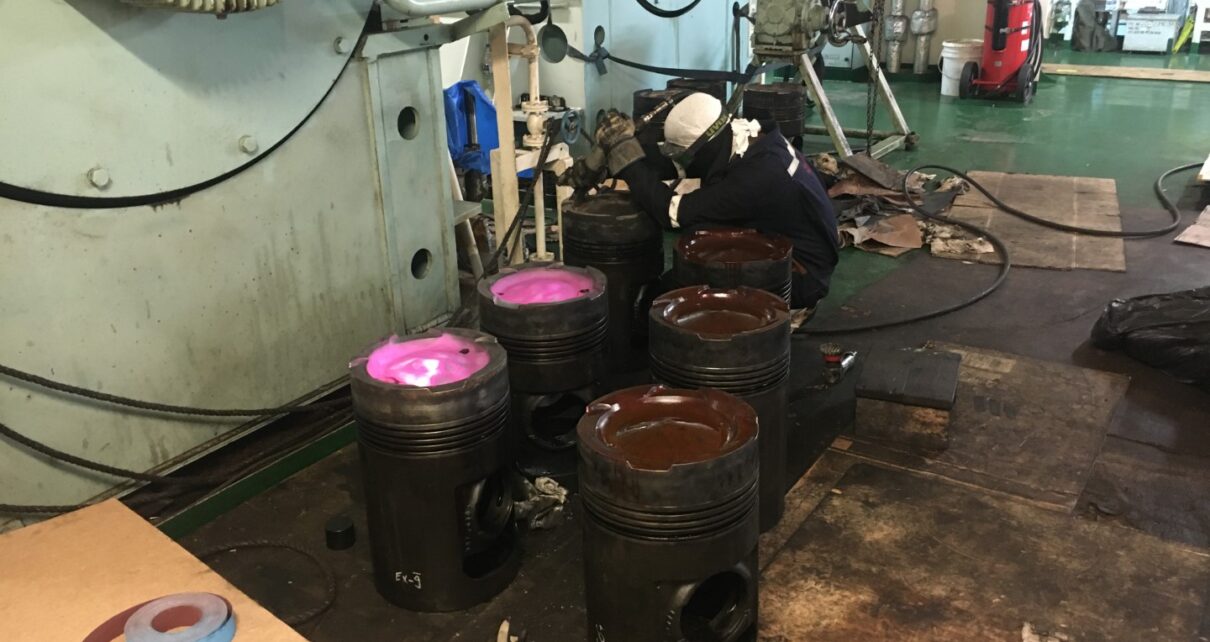Types of NDT test carried out onboard are discussed in this article in a detailed manner. Please read step by step.
There are several types of non-destructive testing (NDT) methods that can be used to inspect metals without damaging or altering the material. Here are some common types of NDT tests on metal:
- Ultrasonic Testing (UT): This technique uses high-frequency sound waves to detect surface and subsurface defects in metals. UT can detect cracks, voids, and other irregularities that may not be visible to the naked eye.
- Radiographic Testing (RT): RT involves passing X-rays or gamma rays through a metal component to create an image that can reveal internal defects or anomalies. This method can detect cracks, porosity, inclusions, and other defects in the metal.
- Magnetic Particle Testing (MPT): MPT is a technique used to detect surface and near-surface flaws in ferromagnetic materials. A magnetic field is applied to the metal component, and iron oxide particles are used to reveal any cracks or other defects in the metal.
-

credit:www.marinersgalaxy.com Liquid Penetrant Testing (LPT): LPT is a method used to detect surface defects or discontinuities in metals. A liquid penetrant is applied to the surface of the metal, and any excess is removed. A developer is then applied, which draws out any penetrant that has seeped into cracks or defects in the metal, making them visible to the inspector.
- Eddy Current Testing (ECT): ECT is a method used to detect surface and subsurface flaws in metals that conduct electricity. Eddy currents are induced in the metal by a coil, and the resulting magnetic field is used to detect any changes or anomalies in the metal.
Each of these NDT methods has its advantages and limitations, and the appropriate method to use will depend on the type of material being inspected, the size and shape of the component, and the nature of any suspected defects or anomalies. It is important to select the appropriate NDT method for the specific application and to follow industry standards and guidelines to ensure accurate and reliable results.
Most Types of NDT test carried out onboard
Mostly we have two types, one is visual and other one is Dry Penetration Type.
Dye Penetrant Testing (DPT), also known as Liquid Penetrant Testing (LPT), is a non-destructive testing method used to detect surface-breaking defects or discontinuities in metals and other non-porous materials. The process involves the application of a penetrant fluid to the surface of the material, which is then drawn into any surface-breaking defects through capillary action. After a set dwell time, the penetrant is removed from the surface and a developer is applied, which draws out the penetrant trapped in the defects and makes them visible to the inspector.
Here are the steps involved in a typical dye penetrant test:
Surface Preparation: The surface to be inspected is cleaned and dried to remove any dirt, oil, or other contaminants that could interfere with the test results.
Application of Penetrant: The penetrant fluid is applied to the surface of the material, typically by spraying, brushing, or immersion. The penetrant is left to dwell for a specified amount of time to allow it to seep into any surface-breaking defects.
Removal of Excess Penetrant: After the dwell time has elapsed, any excess penetrant is removed from the surface using a solvent or other cleaning agent. Care must be taken not to remove any penetrant that has seeped into defects.
Application of Developer: The developer is applied to the surface of the material, which draws out any trapped penetrant from defects and makes them visible as a bright-colored indication against a contrasting background.
Inspection: The surface is inspected for indications, which are evaluated based on their size, shape, location, and other characteristics. Any defects or anomalies that are detected can be further evaluated using other NDT methods or by removing the affected material for further analysis.
Dye penetrant testing is a versatile and widely used NDT method that can detect a wide range of surface defects in metals and other non-porous materials. It is relatively simple and inexpensive to perform, but it does have limitations. For example, it is not effective for detecting defects that are completely enclosed, and it may not detect very small defects or those that are located deep below the surface. Additionally, it can only be used on non-porous materials that do not absorb the penetrant fluid.



